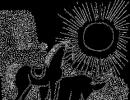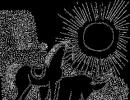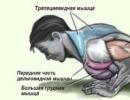How to make a chain sprocket yourself. Bicycle stars. Gear ratio of driving and driven stars
Instead of a round drive sprocket, an elliptical sprocket was proposed to be used on a bicycle back in 1892 by Professor V. Prusakov. He decided to place the cranks along the minor axis of the ellipse, which made it possible to more rationally use the forces of the cyclist. Experiments have shown that even an inexperienced cyclist on a car with an elliptical sprocket spends approximately 30% less energy than on a cycle car with a round one moving at the same speed.
asterisk. And according to American engineers, the use of an oval gear increases average speed cyclist by about 14%.
But, despite all this, the non-circular sprocket was not widely used either in our country or abroad: the bicycle industry was not ready for the production of non-traditional chain drive elements.
However, it is not so difficult to calculate and make an elliptical sprocket on your own. It is only necessary to take into account that its effectiveness depends on the ratio of the major and minor axes of the ellipse: the larger it is, the more advantageous its use is. Given this and the design features of the bike, determine maximum size major axis and minimum - minor axis of the sprocket. Then you have to
where 12.7 is the step bicycle chain, n is the number of teeth of the elliptical sprocket (selected by the same method as for a chain drive with round sprockets). The length of the ellipse is calculated by the formula:
where a is the major axis of the ellipse, b is the minor axis of the ellipse. Having chosen the size of one of the axes of the ellipse, we find the value of the other axis of the ellipse. It must be such that it matches L** to the second decimal place. \ "On the sheet metal workpiece from which the sprocket will be made, an ellipse of the centers of the rollers is built according to the formulas:

where a is the major axis of the ellipse, b is the minor axis of the ellipse; x and y - Coordinates of the point relative to the center of the ellipse; a = 0°, 10°, 20° …… 360"
Further, this closed curved line is divided using a compass into n equal parts with a step of 12.7 mm. Now it will be no more difficult to cut an elliptical star out of metal than a round one. Studies have shown that the efficiency of the ellipse sprocket increases if the minor axis of the ellipse “lags behind” the connecting rod by 10 ° ... 25 °. For sports and sports-tourist bicycles of the Kharkov Bicycle Plant, an elliptical sprocket with 46 teeth and axle sizes a = 110.18 mm, b = 73.981 mm with a ratio a / b = 1.49 was calculated and manufactured. The lag of the minor axis of the ellipse from the connecting rod is 15 °. All other dimensions of the sprocket are shown on the drawing.
And now the most interesting!
One of my readers made an asterisk according to the drawings of this article:

Here is what he writes:
Operational properties and manufacturing principle read here . From myself I will say that the effect simply shocked me, I did not even imagine this. For example, on a forward with a gear of 28-34 (front-rear chainring) I drove up a very steep and long mountain and wanted to fall and not get up, my tongue was on my shoulder, my legs fell off. On this lisapede, after installing elliptical stars with a gear of 32-28, I drove up the same mountain and even my breathing didn’t go astray, my legs felt much less stress. Moreover, the speed of movement up this mountain on the forward is 6-6.5 km / h, and on this 7.5-8 km / h !!! And in a straight line on asphalt, the speed of movement increased.
How to make homemade sprocket block for bicycle. The road bike is simple and reliable. It has a trouble-free foot brake, which is important when driving off-road, but there is no gear shift, as, for example, in multi-speed bicycles of the “Tourist” type, which is so necessary when driving over rough (with hills and ravines) terrain.
However, the "Tourist" has only a handbrake, which, in my opinion, has neither smoothness, nor reliability, nor wear resistance, and it costs much more. Is it possible to combine the advantages of both types of bicycles? It turns out that if you think about it, it is partially possible by installing on the road instead of the standard driven sprocket block of three coaxial sprockets rigidly fastened (welded) through spacer wire rings.
First (small) star, having 18 teeth, standard. It is hardened, therefore, for subsequent welding into a block, it must be released, that is, heated on fire (in a fire or over a gas burner) to red and cooled in air. The second and third sprockets, respectively with the number of teeth 24 and 28, are self-made. They are made of 2.3 mm thick sheet steel using the following technology. On a small sheet of drawing paper, a circle is drawn with a compass (for the second asterisk with a diameter of 97 mm).
Then the paper is placed on soft cardboard (or several layers of newspapers). A part of a bicycle chain (24 links) is placed on the sheet so that the centers of the axes of its links are located approximately on the drawn circle, and the distance between the axes of the first and last link is equal to the chain pitch - 12.7 mm.
This part of the chain is carefully covered with a piece of plywood sheet and through it is pressed against the drawing paper by hand. The prints of the axes will remain on the paper. Then this imprint is glued onto the steel sheet and through it on the metal, in the middle of the printed circles from the axes, the centers are punched and 24 holes with a diameter of 8.5 mm are drilled.
Next, a sprocket blank is cut out of the steel sheet with a chisel or hacksaw. It remains only to mark according to the template, carefully grind each of her teeth on an emery and file, and also make a central hole with a diameter of 51 mm. The third sprocket was made in the same way, only the diameter of the circle on the drawing paper was 112 mm and 28 chain links were laid on it. In place of this asterisk, you can install and ready from the old children's bike- it has the same number of teeth with the same pitch. Only before welding it also needs to be released.
Two annular spacers with an inner diameter of 52 mm are bent from 6 mm steel wire. Before connecting the sprockets into a single block, for the convenience and reliability of welding them with rings, several technological holes with a diameter of 12 mm were drilled in self-made sprockets. After that, having ensured the coaxiality of the sprockets to prevent the beating of the gear rims, the rings and sprockets are sequentially welded to each other with points evenly distributed around the circumference.
The manufactured block of sprockets is mounted on the outer part of the driving cone of the rear hub of the bicycle and the regular (smaller) sprocket is welded to it in a circle with a reliable continuous seam. It would be possible to simply fix the block with a "native" spring ring, as usual, but there is no guarantee that the thermally tempered splines of the small sprocket will withstand the increased loads. For welding work, the driving cone is released from the bearing and rollers and thermally released in the same way asterisk. Re-hardening of the part, as shown by the operation, can be omitted.
The axle length is enough to fix the drive wheel with the sprocket block in the rear fork of the bicycle. But simple and reliable homemade mechanism no matter how hard I tried, I could not design the gear shift. Therefore, I installed a standard mechanism from the old Tourist bicycle on my road builder, rigidly fixing it with an M10 bolt right in the frame hole.
The gear lever is located under the seat. For those who do not have such a speed switch, I advise you to prepare two pieces of chain with locks at both ends: the first with five links, the second with nine. Then, before the next trip, even at home, you can lengthen (or shorten) the chain and put it on the desired sprocket, depending on the intended nature of the route, speed and your physical form.
For example, if you have to travel light on the highway, then a smaller sprocket and a shorter chain (without inserts) are selected. When it is necessary to overcome the path along a country road, and even with a load, a long segment is inserted into the chain - for a larger sprocket.
Star block on the drive cone of the rear hub of a road bike: 1 - small sprocket (z = 18, t = 12.7, from a road bike); 2 - intermediate sprocket (z = 24, steel, sheet s2.3); 3 - large sprocket (z = 28, steel, sheet s2.3); 4 - ring distance inserts (steel, wire with a diameter of 6); 5 - leading cone of the bushing; 6.12 - anthers; 7 - tip of the rear fork of the bicycle; 8 - axis; 9 - nut; 10 - washers; 11 - fixed cone; 13 - bushing body; 14 - cup; 15 - leading roller; 16 - bearings

Making an asterisk

Making an impression: 1 - drive chain; 2 - paper sheet

Welding of distance inserts with an asterisk through technological openings: 1 - an asterisk; 2 - remote insert
One of the problems with the bicycle pedal drive was and still is the need to change the torque to the drive wheel depending on the road conditions. And I must say that the designers solve it, but in different ways. They even created planetary drive bushings, but they are complex, and therefore not cheap. Therefore, most often a multi-stage transmission with several sprockets and mechanisms for transferring and compensating the length of the chain are installed on the rear wheel. This is the most developed and inexpensive option. But the number of stars (usually three, sometimes four) is sometimes not enough. Then, to increase the number of "speeds", the leading sprocket is also made two- and even three-stage.
The essence of such a device is that the drive sprocket is cut into four sectors, which, by means of a multi-stage cam, are simultaneously symmetrically moved apart in all directions (or shifted back), changing the gear ratio of the drive. But the problem here is that the sectors are covered not by a belt, but by a chain, and how to move them apart? Then, with the teeth, we leave only two opposite sectors to ensure the transmission of torque, and cut off the teeth of the other pair of sectors - they will only serve to support and guide the chain. Now, when one of the sectors with teeth is out of engagement, by manually turning the cam we move apart (shift) the sectors, changing the torque. But in practice it is possible to do without smooth reference sectors. Then the chain will cover the "quasi-elliptical" contour. Thus, the idea of an elliptical sprocket, which is known to significantly increase the efficiency of the drive, is also implemented here.
You can install such a two-sector sprocket on any bike instead of the standard one, by providing the chain drive with a simple spring-lever compensator near the driven sprocket.
So, the design of the device. First, we note that all of its parts are steel, and the flat ones are made of 3 mm sheet.
A guide disc with a diameter of 260 mm is welded to the inside of the bottom bracket head of the regular right crank. Two axes are rigidly mounted (welded) into the disk at a distance of 65 mm from the center, on each of which a lever is freely put on with a spacer washer (a little more than a cam thick). A nine-tooth sector cut from a standard 28-tooth sprocket of a children's bicycle is screwed to each lever through washers with two screws. The screws located closer to the axes have grooves (pins) at the ends that come into contact with the ledges of a two-lobe multi-stage cam loosely put on the carriage shaft. To turn the cam, handles are welded to its last ledges. The screws with the pins of both levers (and hence the gear sectors) are pulled together by a normally compressed coil spring. The depth of the cam ledges in the process of pre-assembly and adjustment is adjusted with a file so that the first teeth of the sectors freely enter the chain links. For the same purpose (so that the chain does not suddenly jump off without hitting the first tooth), antennae - guides - are welded to it. So that at the maximum disclosure of the sectors, the antennae do not cling to the frame of the bicycle, they should not be made wide. In extreme cases, you can tweak the frame a little with a hammer.
To shift gears, you must first position the connecting rod so that one of the sectors is out of engagement with the chain. Bending over, cyclist right hand turns a multi-stage two-lobe cam with a handle into one or more ledges, thereby increasing (or decreasing) the torque transmitted by the drive.
Since the total difference between the chain links at the maximum separation of the gear sectors and at the minimum displacement is 16 pieces, the drive also requires a spring-roller compensator for changing the length of the chain. The compensator consists of a bracket rigidly fixed on the rear fork of the frame and a swing arm hinged (on the axis) suspended on it. At the ends of the lever, on their axes, there are two rollers made of ball bearings 201, "compressed" with washers to guide the chain. One end of the lever is connected to the frame by a spring brace.
It is, of course, better to use hand brakes here, but you can also use foot brakes. To do this, an additional bed catcher made of tin should be installed on the rear fork of the frame, which will prevent the sagging part of the chain from getting between the wheel and the frame. In this case, the compensator lever will rest against the fork feather and will return to its place after the end of braking under the action of the spring.
To ensure the operation of the device, it is necessary to lubricate all contact surfaces and links well.

Multi-speed drive sprocket:
1 - right connecting rod; 2 - guide disc; 3 - two-petal cam; 4 handle for turning the cam (wire 04, 2 pcs.); 5 - chain; 6 - normally compressed spring; 7 - gear sector (from the leading 28-tooth sprocket of a children's bicycle, 2 pcs.); 8 - lever (2 pcs.); 9 - a finger of fastening of the lever to a disk (2 pieces); 10 - carriage shaft; 11 - screw securing the sector to the lever (2 pcs.); 12 - screw securing the sector to the lever with a pin (2 pcs.); 13 - distance washer (2 pcs.)

Chain length compensation mechanism:
1 - right connecting rod; 2 - guide disc; 3 - handle for turning the two-lobe cam; 4 - chain; 5 - right feather of the rear fork; 6 - bed catcher (tin plate s0.5); 7 - spring (from an old expander); 8 - bracket (St3, sheet s3); 9 - rotary lever (St3, sheet s3); 10 - restrictive washer (4 pcs.); 11 - drive sprocket rear wheel; 12 - roller (bearing 201, 2 pcs.)






